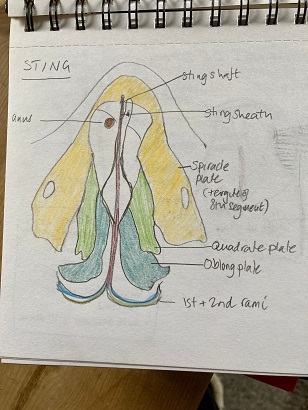
Here we are with the last blog of February already. It’s warming up a little here in the Scottish Highlands and the days are longer for sure. The bees are out on sunny days looking for pollen and they land on me in anticipation as I sit with a cup of tea in the garden. I had to sit very still the other day as one crawled through my hair and out onto my forehead. They always fly round me at this at this time of year when the weather tells them they should be out and about but there is very little forage to find. They are attracted to my mid- morning snacks. The viburnum and sweet box are top garden favourites, and snowdrops are getting attention too but there is not enough to satisfy them yet.
I slipped up this year by not providing enough safe apiary water sources in sunny positions. A call from a neighbour had me hurrying along the road to investigate the “small bees that are trying to nest in the doorstep”. It turns out that the doormat is black plastic attracting a lot of water underneath and also the morning sun which heats the water to the perfect collection temperature for our bees. They are all over the cement between the concrete slabs licking minerals from the green mouldy parts too. Fortunately, my neighbour is fascinated and we watch together for a few minutes and I answer her many questions. She removes the doormat and the steps dry quickly. In a couple of days, the bees stop visiting and she can use her front door again. Meanwhile, I set up a couple of new water dishes using pot plant saucers lined with sponge which are soon busy water stations.
This is a busy time for me because I give presentations between January and April, mostly by Zoom; 5 done and 4 to go before the end of April! Last night’s visit to Elgin was my first time away from the desk for a long time. It was a treat to be facing a live audience again and interacting with friendly faces. Moray Beekeepers’ Association is education-focused with a training apiary and a strong teaching team of well qualified people, and a lot of members attending courses and going on to sit beekeeping exams.
Guest Blog.
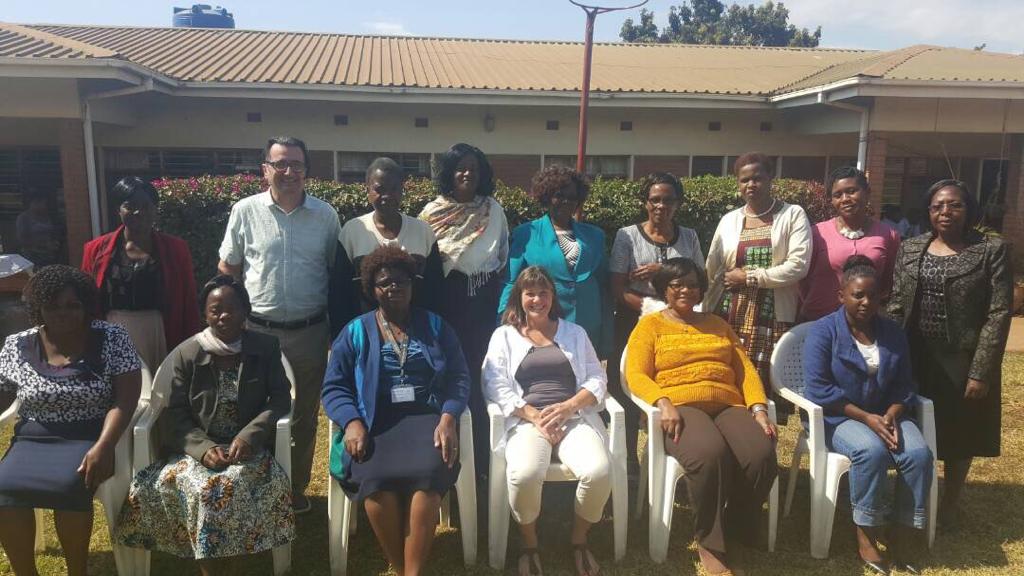
This guest blog by my good friend Jane Geddes features education and learning styles which will help everyone get the most out of beekeeping education and training.
Jane’s been a regular Beelistener guest blogger since I started the blog nearly 3 years ago. For new readers, Jane has been beekeeping for 8 years and is working her way through the Scottish Beekeepers’ Association (SBA) exam system by self-directed learning. Jane has a nursing and midwifery background and specialised in nurse education so is well placed to teach beekeeping. She visited Malawi regularly to teach midwifery tutors out there, so she is up to date in all things do with learning styles and training delivery. “I was a midwife for 35 years, and retired (but am not “tired”) in 2018. I worked in all areas of midwifery, including teaching. Latterly I worked on Scottish Government funded projects in Malawi. I obtained my first colony of bees at the beginning of 2015, and have been hooked since then. I have completed 3 Scottish Beekeeper Association modules, with another in the pipeline in 2023. I am obsessed with surfski paddling, and enjoy CrossFit, crochet, knitting and reading. And life!”

Jane is very sporty and can be found paddling on the Moray Firth most days, riding her bike down to Aviemore and back (a day trip in the car for me) or climbing a wall.
Thank you, Jane, for sharing this great information with us and taking the time to write the blog. It’s long time since I got my nurse teaching diploma and there are so many changes and new things to learn about education.
How do you Learn?
I have always been curious and keen to investigate new ideas, find new information and dare I say it, I like doing exams! Whether guitar, piano (a long time ago now), studying, and extending my knowledge in the workplace, there is an internal drive that spurs me on.
I enjoy it. When studying though, life gets in the way sometimes and the depth of the desired knowledge can be compromised by external commitments which can be frustrating.
The secret is, I think, to acknowledge that there is no one perfect way to learn and embed information into the long-term memory. At school, learning by rote was favoured, the teacher the fount of all knowledge (and at times terrifying characters existed)! Over time, I found myself working, also teaching students. Part of this role included studying how people learn.
VARK: A Key to Learning.
Understanding our own learning styles and how we can utilise them is a distinct advantage, particularly when we have such an amazing array of online resources, literally at our fingertips. We can also learn through social interaction, observing others, such as family and peer groups; through experience and trial and error. We can have the “need” or “want” to learn as described by Phil Race (Race 1993). Learning itself does not need to be a passive experience. We can draw, watch YouTube, visualise, hear, tell stories, read and write lists, and be active in a variety of ways to embed information.
The above alludes to a model called VARK – (Visual, Auditory, Reading/Writing and Kinaesthetic) learning styles. The initial model was developed in the 1920s, suggesting and identifying the more common ways that people learn. In the 1920s, the model identified three parts- Visual, Auditory and Kinaesthetic (VAK) learning strategies. It was suggested that we all favour one specific style. In the 1980s however, Neil Fleming from New Zealand developed the model further, adding Reading/writing to the list (VARK). Fleming worked as an educator and noted, during school inspections, that some fantastic teachers were unable to “reach” some students, failing to motivate and excite them, however less talented teachers appeared to be more successful, engaging the majority of students. Further research resulted in the amended model which will be described here.
How to Identify Your learning Style.
There are many freely available questionnaires that can be used to identify our own preferred way of learning. For example, (https://vark-learn.com/the-vark-questionnaire/) A fun thing to do and may be a useful strategy to use prior to SBA exams! I have signed up for one of the SBA modules and have been exploring my preferred learning style (I am a mad mixture)! So, here are some thoughts about how we can use the resources available to us to promote pleasure in learning.
If you do use the quiz, and you find that you are a visual learner, try drawing, colouring in, and draw diagrams, make charts, watch videos. Browsing websites with a focus on a particular module is also enjoyable, such as Ann’s excellent blog
(https://www.beelistener.co.uk/honey-bees/how-to-get-honey-bees-buying-swarming-bait-hives/) – this has many links to other websites and videos. For example, I stumbled across a beautiful short film about Aberdeenshire beekeepers “Ode to the Beekeepers” which was the perfect end to an afternoon of drawing pictures and doing mind maps.
If you are an auditory learner, arm yourself with Spotify podcasts, entering the word “beekeeping” into the search facility. Auditory learners enjoy discussion, listening and feeding back in a group discussion, making up stories, or remembering situations to assist in the processing and memorising of information (for example, the first time I experienced a swarm, lodged in a broom bush. I was watching Ann lying underneath it in the grass, no gloves, no head covering, looking for the queen, and encouraging me to come close and feel the heat from the swarm, touch it.. reassuring me that their tummies are so full of honey they won’t be able to sting you….). I told the story to The Boys Next Door when I looked after them the following week. Making notes and reading these aloud is another successful strategy.
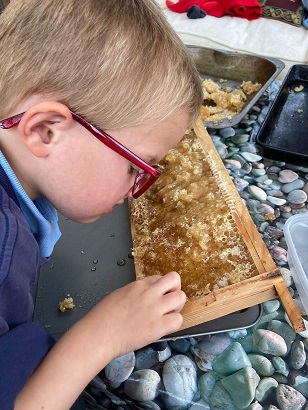
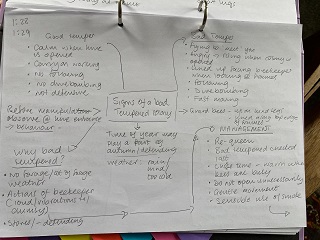
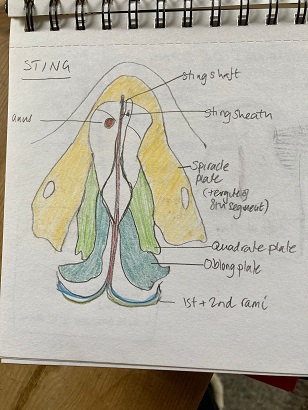
Making lists, writing notes, making mind maps, and hanging these up all over the house is useful for those who prefer to Read/Write. Preferring to study alone, read/write people like making presentations, writing notes from memory, and using coloured highlighters to identify important points make learning into bite sized chunks. I have done this and left piles of notes on lurid yellow paper all over the dashboard of the car (I am not the driver!!).

Kinaesthetic learners like touching, feeling, “doing” something to provide the “hook’ upon which to consolidate learning (for example above sitting with the swarm experience). Experiencing the noise, the blackness of the bees leaving the colony in front of my eyes and then following them down to the broom bush was an amazing scene.
Moving around, being active and learning in short bursts is typical of the kinaesthetic learner. Apart from following swarms, making flashcards, having quizzes, doing “demonstrations” – using empty matchboxes as “hives” to memorise a variety of manipulations are all active ways to learn. Reciting from memory, aloud, while walking the dog is a successful method, although a wee bit disconcerting for the neighbours! When teaching I encouraged some of the student midwives to knit during class (simple patterns!), which helped focus. It was also fun, which is what learning should be.
Gaining a fuller understanding of how we “tick” or learn, and finding what appeals to us to maximise learning, and to embed information, is a satisfying thing to do. It also enhances our mentoring roles and helps us assess learners and deliver material in the most relevant ways for them.
If you enjoyed reading this, you can subscribe to receive future posts by email. Also, if this article helped you with your work, please consider making a small donation to keep our site running. You can do this through the “Donate with Paypal” button that appears at the side of the screen if you are using a desktop, or by scrolling towards the bottom of the page if you are using a mobile.
Thank you, Ann 🐝

Absolutely spot on perspective on how we learn and memorise. Would further support the ‘drawing’ aspect. Often people think they ‘know’ something because they have ‘understood’ it when they read it but the difference becomes apparent if you ask them to explain it to you. If they ‘know it’, in general they will be able to do this and also, to draw it in a simple diagram. If they just ‘understood it’, they will often struggle to be able to give the whole explanation. It is a good self-test way of learning and reinforcement for exams too.
Hi Maurice, Thanks so much for the feedback! I also teach the dog, but he doesn’t talk back! but useful to speak out aloud to embed information anyway. Jane
👍😁😁😁 my dog.is more vocal. But not so good at drawing 😁😁
Another really good article Ann. Everyone learns by different methods – including being taught on how to factually solve a practical beekeeping issue and hands on experience.
Thank you for your comments on Jane’s excellent post, Alistair.
Thanks for the article about learning styles! as I was reading it, I realised I could perhaps do some distance learning modules about beekeeping as I’m so isolated on South Uist. Any recommended sources? I think I am probably a read/wirte learner…
Hi Margaret – yeah distance learning is an excellent way forward. I often wish that there was a continual assessment type thing – maybe a portfolio to present (or something similar) – designing a poster/ PowerPoint presentation (not necessarily a live event)! etc instead of “exams” which I think terrify some people. Have you got bees? Shame you feel isolated – Jane